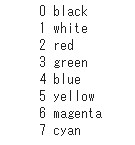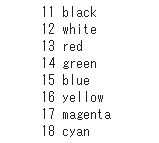Pythonで配列の各要素をfor文で取得する場合は、以下のようにします。
colors = ['black', 'white', 'red', 'green', 'blue', 'yellow', 'magenta', 'cyan']
for c in colors:
print(c)(実行結果)

ここに、インデックス番号付きで各要素をする場合は
colors = ['black', 'white', 'red', 'green', 'blue', 'yellow', 'magenta', 'cyan']
i = 0
for c in colors:
print(i, c)
i += 1(実行結果)

とも書けますが、Pythonのenumerate()関数を使うと
colors = ['black', 'white', 'red', 'green', 'blue', 'yellow', 'magenta', 'cyan']
for i, c in enumerate(colors):
print(i, c)(実行結果)

となります。
さらに開始値を0以外にしたい場合は、enumerate()関数の引数に開始値を追加し、
colors = ['black', 'white', 'red', 'green', 'blue', 'yellow', 'magenta', 'cyan']
for i, c in enumerate(colors, 11):
print(i, c)(実行結果)

とします。



コメント